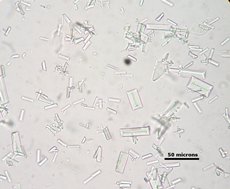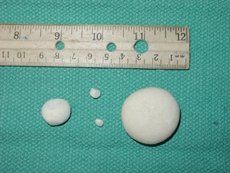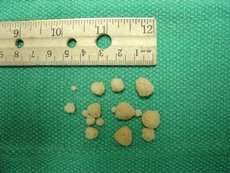Bladder Stones in Dogs
Types and How They Form
Bladder stones in dogs (also referred to as
uroliths or calculi) are increasingly common, and can
affect both male and female dogs of all breeds and all ages.
In other cases, however, bladder stones in dogs can often cause excruciating pain and life threatening consequences. The most dangerous outcome is when a dog bladder stone becomes lodged in its urethra, preventing the dog from passing urine. This can result in illnesses such as uremic poisoning, acute canine renal failure, hyperkalemia, or septicemia - which can prove to be fatal if not treated as a medical emergency.
In the following article, we give an overview of:
We will also examine in detail the role of dog food and diet for canine bladder stones. This includes prescription dog food or other vet recommended dog food, homemade dog food recipes, and natural supplements for the treatment and prevention of canine bladder stones.
How Canine Bladder Stones Form
A canine bladder stone forms when microscopic crystals accumulate and unite in the dog's urinary tract system.
|
A diagnosis of crystals in your dog's urine may be of concern if:
- Your dog has a history of urinary stones;
- Your dog presently has a urinary tract infection, or has a history of UTIs;
- Your dog is susceptible to other causes of canine bladder stones.
Additionally, crystals may form in urine within 30 minutes after collection, creating a false positive, so it's important that testing is done promptly.
As per Narda Robinson, DO, DVM, "Dispelling Myths About CaOx Uroliths, Veterinary Practice News - "Individuals may excrete millions of urinary crystals daily without producing stones. Fluids flushing the urinary tract counter the supersaturation of stone-forming solutes. Ensuring regular intake of clean, fresh water serves as the primary prevention strategy."
If
your dog has been diagnosed with crystals but has
no symptoms, no urinary stones and no canine
urinary tract infection,
you should not
be concerned and do not have to do anything!
If your veterinarian automatically recommends any medication,
prescription dog
food or other vet recommended dog food ... we suggest you think twice!
Do
your research, challenge your vet, and you may even wish to
seek
a
second veterinarian opinion.
According to Patricia Schenck & D.J. Chew from the book: Home-Prepared Dog and Cat Diets - ”The frequency of bladder stones in dogs is not high enough to justify dietary modification before a stone forms, and treatment of crystalluria is unnecessary in dogs that have never formed a urolith”.
Types of Bladder Stones in Dogs
The two most common types of canine bladder stones are Struvite and Calcium Oxalate Stones.
Struvite Bladder Stones in Dogs
Struvite urinary stones (comprised of struvite crystals - aka magnesium, ammonium, phosphate) are one of the most prevalent bladder stones in dogs.
|
Breeds of dogs most susceptible to forming struvite bladder stones appear to be mixed breeds, Miniature Schnauzers, Shih Tzus, Bichon Frise, Cocker Spaniels and Lhasa Apsos.
Calcium Oxalate (CaOx) Bladder Stones in Dogs

|
Unlike struvite stones, calcium oxalate bladder stones occur significantly more frequently in male dogs, and do not appear to be associated with urinary tract infection in dogs.
Although CaOx dog bladder stones can affect all breeds, those most predisposed are Miniature Schnauzers, Lhasa Apsos, Yorkshire Terriers, Bichon Frise, Shih Tzus, and Miniature Poodles between two and ten years of age.
The Bichon Frise appears to be particularly prone to recurring oxalate bladder stones, and they often seem to have a recurrence within the first year after surgery.
Less Common Dog Bladder Stones
Other - far less common - bladder stones in dogs are:- Urate Stones are found mainly in older male Dalmatians and to a lesser degree in English Bulldogs and Yorkshire Terriers.
- Cystine Stones form due to a genetic defect that causes excess cystine in the urine. Signs of cystine calculi typically do not appear before 3 to 5 years of age, and the recurence rate is high.
- Calcium Phosphate Stone, and
- Silica Stones.
Additionally, bladder
stones in dogs can consist of a
core of one or more minerals surrounded by
outer
layers of different ingredients. They also may
not even be comprised of the same
crystals that may have been identified in your dog's
urinalysis.
The only way to determine the type of your dog's bladder stone is to
analyze a sample that
has either passed naturally or been removed via surgery.
Although much less common, a dog can also form stones and
crystals in other parts of its urinary tract including the
kidney or urethra. Kidney stones in dogs
(nephroliths) generally do not cause
significant
disease but, in some circumstances, they can lead to
pyelonephritis (a bacterial
infection of the dog's upper urinary tract and kidney) and
chronic
renal failure in dogs.
Suspect bladder stones in your pooch?
If you would value a second opinion about your dog's bladder stone diagnosis and treatment, we highly recommend you consider the following very reputable on-line service.Ask a Vet is extremely inexpensive (average cost $9 - $15) and offers prompt one-on-one response from a qualified veterinarian.
CONTINUE:
- Canine Bladder Stones - Causes, Sytmptoms, Diagnosis and Treatment
- More on Bladder Stones in Dogs - Types and How They Form
- Canine Urinary Tract Infection - Causes, Symptoms and Treatment
- Dog Bladder Infection - At Home Prevention Tips for Dog Urinary Problems - Prevent and Avoid Recurrence (Coming Soon)
- Canine Bladder Stones Prevention - Prescription Dog Food, Homemade Dog Food Recipes, Natural Dog Supplements and Other Home Care Tips (Coming Soon)
- Canine Kidney Failure Symptoms - Renal Failure in Dogs and Renal Dog Food Diets
- Low Protein Dog Food - Unlike high protein dog food, reduced protein dog foods are usually only indicated as a treatment aid for various dog health problems
You are here: Home > Bladder Stones in Dogs
